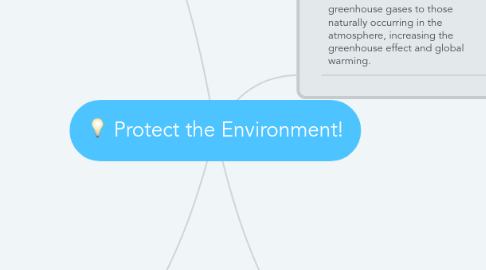
1. WHAT CAN WE DO?
1.1. RENEWABLE ENERGY (environment-friendly)
1.1.1. WAVE ENERGY
1.1.1.1. (large storms offshore)
1.1.2. BIOFUEL
1.1.2.1. any kind of fuel made from processing plants (e.g. ethanol, biodiesel, pellets, biogas from animals' excrement, etc.)
1.1.3. SOLAR POWER
1.1.3.1. photovoltaic cells
1.1.4. HYDROELECTRIC POWER
1.1.4.1. e.g. energy from waterfalls
1.1.5. WIND POWER
1.1.5.1. wind turbines
1.1.6. TIDAL POWER
1.1.6.1. hydropower, energy of the tides
1.1.7. GEOTHERMAL ENERGY
1.1.7.1. thermal energy generated and stored in the Earth
2. Eco-friendly Tips!
2.1. Separate waste collection
2.2. Only buy what you need
2.3. Use bags that can be used again for shopping
2.4. Do not buy useless packaging
2.5. Opt for loose foodstuffs
2.6. Drink tap water
2.7. Install flow reducers on all taps
2.8. Repair leaks
2.9. Close the tap while cleaning teeth or shaving
2.10. Choose a shower rather than a bath
2.11. Turn off the lights when they are not needed
2.12. Use energy saving lamps
2.13. Use a fully loaded washing machine and dishwasher
2.14. Wash at low temperatures
2.15. Have double glazing installed
2.16. Buy class A+, A++ electrical appliances
3. Humans are increasingly influencing the climate and the Earth's temperature by burning fossil fuels, cutting down rainforests and farming livestock. This adds enormous amounts of greenhouse gases to those naturally occurring in the atmosphere, increasing the greenhouse effect and global warming.
4. Pollution
4.1. Climate change
4.2. Greenhouse Effect
4.2.1. Greenhouse gases
4.2.1.1. Greenhouse gases protect the planet, they surround the Earth, reflect the heat in the atmosphere back to Earth so it doesn't become cold. If the atmosphere contains too much of these gases, the whole Earth becomes a hotter and hotter greenhouse.
4.2.1.2. CO2 (Carbon Dioxide) is the main greenhouse gas that contributes to global warming.
4.2.1.2.1. CARBON FOOTPRINT is the measure of how much CO2 we produce every day.
4.3. Global Warming
4.3.1. Over the years, a few degrees of warming starts causing changes. For example, ice melts in the North and South Pole regions. All this new liquid water raises the sea level. Cities built on coastlines could someday be under water! Hot places might became deserts, plants won't grow and animals will become extinct without food available.
